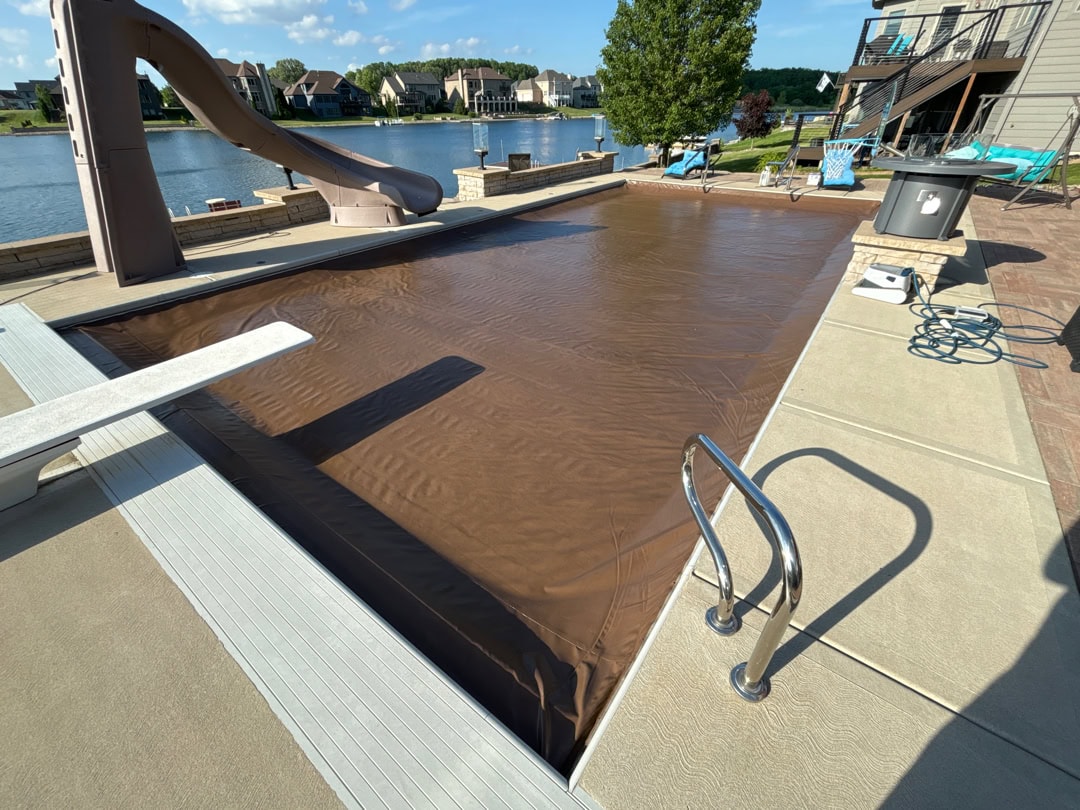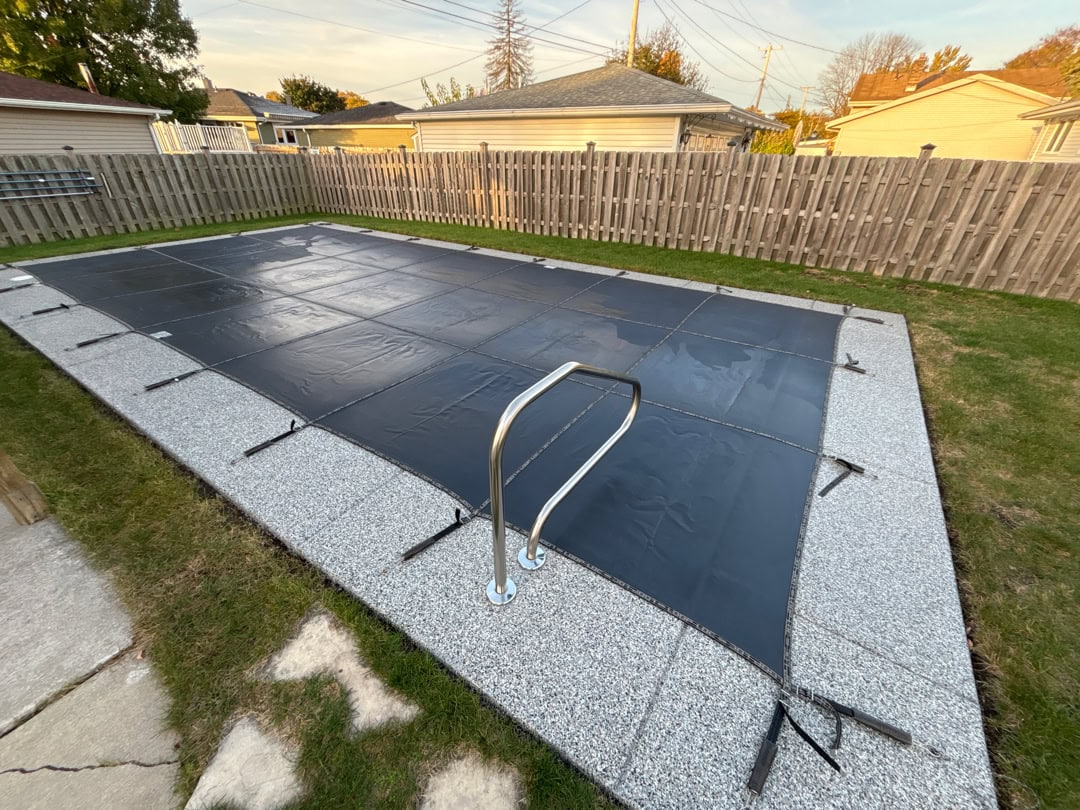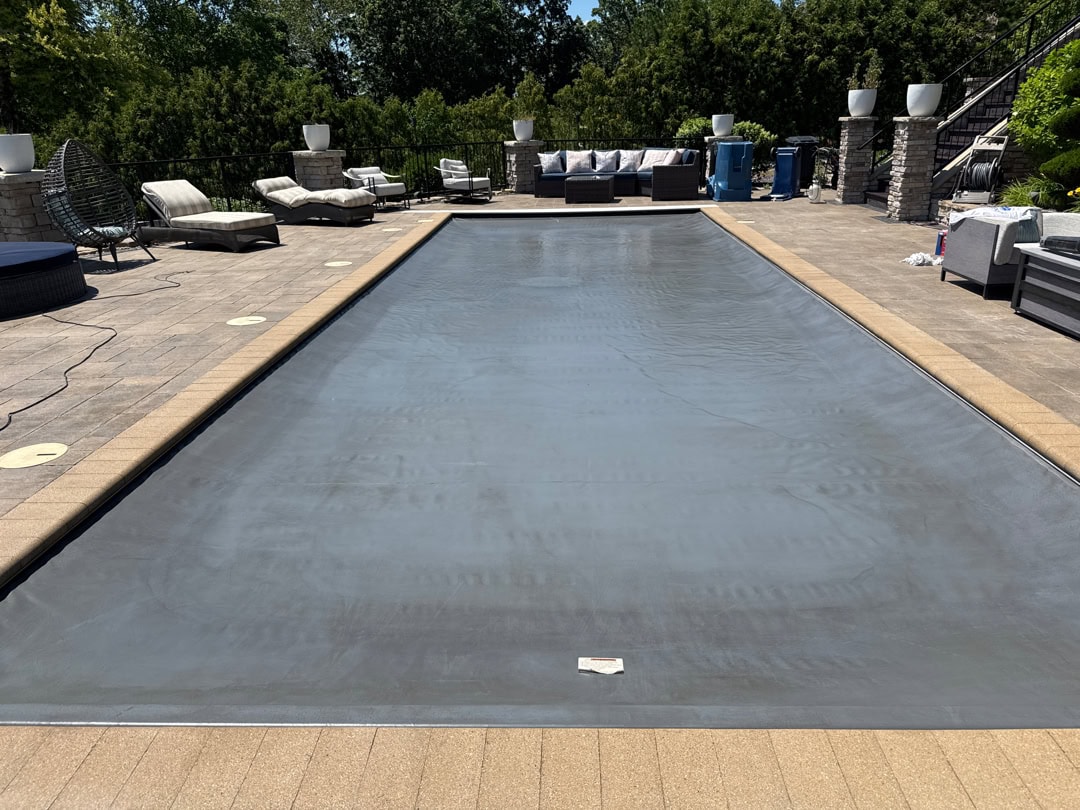Auto Covers vs Manual Winter Covers: Cost, Pros and Cons


Inground swimming pools are a massive investment. Taking care of the pool ensures the longest and best return on your investment is easier with some sort of cover on the pool. The two primary types of inground pool covers are automatic pool covers and manual winter pool covers. Both serve the purpose of protecting your pool, but they differ in price, convenience, durability, function, and efficiency.
For those of us in the Midwest, the winter season brings about a great sadness: it’s time to close the pool. Of course, you need some sort of cover to protect your pool and pool water from the winter elements. You may be drawn to the affordability of winter safety covers and recognize their function, but you also love the convenience of auto covers. It is a tough decision.
Royal Pools G2 Landscaping installs vinyl liner and fiberglass pools. You can fit either with an auto cover or a solid winter cover. You’ll have to consider a few factors when choosing your type of cover, such as maintenance, efficiency, cost, etc. This article will explore the pros and cons of each option to help you make an informed decision.
Cost Comparison of Pool Covers
When weighing the pros and cons of any product or product, cost plays a huge role. If you’ve seen an automatic pool cover or operated one yourself, you may (correctly) assume that they are on the higher-priced side. Solid winter covers, while not as versatile and convenient to use as auto covers, are significantly cheaper.
On average, including installation, auto covers cost about $13,500 (they can range between $12,000 – $22,000). Manual covers typically fall between $2,500 and $5,000. You must replace your cover material every 6-9 years.
Auto Cover Pros

Convenience:
- With the push of a button, an automatic cover opens or closes, making it easy to use.
- Reduces the time and effort required compared to manual covers.
Enhanced Safety:
- Automatic covers are extremely durable, providing enhanced safety. They can hold large amounts of weight, protecting kids and pets from falling in.
- An auto cover can replace the need for a fence around the pool if local regulations require a fence or a safety cover.
Energy and Cost Efficiency:
- Reduces heat loss, which can lower energy costs for heated pools.
- Minimizes water evaporation, reducing the need for frequent refills.
- Keeps out debris, reducing the need for pool chemicals and maintenance.
Durability:
- Typically made from high-quality materials designed to last for years with proper care.
- Offers year-round coverage, offering protection in all seasons.
Auto Cover Cons
High Initial Cost:
- Installation costs range from $12,000 to $22,000, depending on the pool size and system type.
Maintenance and Repairs:
- Mechanical and electrical components require upkeep and can be expensive to repair if they malfunction.
- Material Cleaning – You should deep clean and condition your auto cover at least once a year with a UVA/UVB protectant.
- Rope/Cable Adjustments – Auto covers operate off a motor, ropes or cables, and a pulley system. As the ropes stretch from the weight on the cover, they will need to be adjusted so the cover material continues to come out flush with the shallow end of the pool. Similarly, the cables can bunch up and become too tight over time, requiring an adjustment.
- Material Replacement – You must replace the cover material every 6-9 years. (Similar to a pool liner, being that they are both made out of vinyl.) As the material ages, it begins to become brittle and dry rot. Over time, the material will fray, rip, and holes will appear, resulting in a replacement.
Not Ideal for Harsh Winters:
- Auto covers are not technically winter covers, but they can function as winter covers. You must remove snow and water from atop the cover throughout the winter season using a cover pump.
- Heavy snowfall or ice can damage the cover, requiring additional precautions. For the best protection of the pool and the auto cover, use a winter pool cover on top of your auto cover during the winter.
Manual Cover Pros

Affordability:
- More affordable than automatic covers, with prices ranging from $2,500 to $5,000.
Effective for Winter Protection:
- Designed to handle snow, ice, and harsh winter elements, making them ideal for the snowy season.
Manual Cover Cons
Time-Consuming to Install and Remove:
- Requires effort to properly secure and remove, often needing multiple people. Typic
Less Convenient:
- Unlike automatic covers, manual winter covers cannot be easily opened and closed for daily use. This can limit your swim time during the pool season if you keep your pool closed regularly.
Limited Lifespan:
- Can wear out faster than automatic covers, especially if not maintained properly.
Do Not Double As Safety Covers:
- Winter pool covers are designed primarily for temperature control and keeping debris out of the pool during the winter. They do not provide the added safety precautions that you would find with typical solid or mesh safety covers.
Pool Remains Exposed During Swim Season:
- A winter pool cover leaves your pool exposed to the elements during the swim season. This means extra cleaning and maintenance. Rainwater and debris can affect water chemistry and pool equipment if you do not stay on top of maintenance. To avoid this, purchase a solar cover for summer use.
Conclusion
There you have it, folks! Now that you know a little bit about the differences between these two covers, it’s time to make your decision. We cannot make your decision. We can only educate you on your options.
If convenience, safety, and energy efficiency are your top priorities and budget is not a major concern, an automatic pool cover may be the best option. If you’re looking for an affordable way to protect your pool during winter and don’t mind the extra effort, a manual winter cover is a great choice.
Base your decision on your pool’s needs, as well as your budget and climate conditions. For more educational articles and videos on all things pools and landscaping, check out our learning hub above or get started with a few articles and videos below. Happy hunting!
Automatic Pool Covers: How Do They Handle the Winter?
How Much Does An Automatic Pool Cover Cost?
Uncovering the Nine Hidden Costs of Purchasing an Inground Swimming Pool
Written by Logan Edgemon
